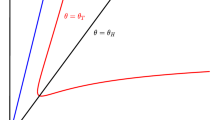Abstract
In this paper, we are concerned with positive solutions of a predator–prey model with Crowley–Martin functional response under homogeneous Dirichlet boundary conditions. First of all, we state some known results and give the existence of positive solutions. Furthermore, the effect of large α is extensively studied. By analyzing the asymptotic behaviors of positive solutions when α goes to ∞, we derive a complete understanding of the multiplicity, uniqueness and stability of positive solutions.
Similar content being viewed by others
References
Bazykin, A.D.: Nonlinear Dynamics of Interacting Populations. World Scientific, Singapore (1988)
Wang, M.X., Wu, Q.: Positive solutions of a predator–prey model with predator saturation and competition. J. Math. Anal. Appl. 345(2), 708–718 (2008)
Wei, M.H., Wu, J.H., Guo, G.H.: The effect of predator competition on positive solutions for a predator–prey model with diffusion. Nonlinear Anal. 75(13), 5053–5068 (2012)
Dong, Q.L., Ma, W.B., Sun, M.J.: The asymptotic behavior of a chemostat model with Crowley–Martin type functional response and time delays. J. Math. Chem. 51(5), 1231–1248 (2013)
Upadhyay, R.K., Naji, R.K.: Dynamics of a three species food chain model with Crowley–Martin type functional response. Chaos Solitons Fractals 42(13), 1337–1346 (2009)
Shi, X.Y., Zhou, X.Y., Song, X.Y.: Analysis of a stage-structured predator–prey model with Crowley–Martin function. J. Appl. Math. Comput. 36(1–2), 459–472 (2011)
Zhou, X.Y., Cui, J.G.: Global stability of the viral dynamics with Crowley–Martin type functional response. Bull. Korean Math. Soc. 48(3), 555–574 (2011)
Li, S.B., Li, Y.L., Dong, Y.Y.: Qualitative analysis of a predator–prey model with Crowley–Martin functional response, submitted
Du, Y.H., Lou, Y.: Some uniqueness and exact multiplicity results for a predator–prey model. Trans. Am. Math. Soc. 349(6), 2443–2475 (1997)
Cano-Casanova, S., López-Gómez, J.: Properties of the principal eigenvalues of a general class of non-classical mixed boundary value problems. J. Differ. Equ. 178(1), 123–211 (2002)
Blat, J., Brown, K.J.: Global bifurcation of positive solutions in some systems of elliptic equations. SIAM J. Math. Anal. 17(6), 1339–1353 (1986)
Pao, C.V.: On Nonlinear Parabolic and Elliptic Equations. Plenum, New York (1992)
Lin, C.S., Ni, W.M., Takagi, I.: Large amplitude stationary solutions to a chemotais systems. J. Differ. Equ. 72(1), 1–27 (1988)
Ryu, K., Ahn, I.: Positive solutions for ratio-dependent predator–prey interaction systems. J. Differ. Equ. 218(1), 117–135 (2005)
Jang, J., Ni, W.M., Tang, M.X.: Global bifurcation and structure of Turing patterns in the 1-D Lengyel–Epstein model. J. Dyn. Differ. Equ. 16(2), 297–320 (2004)
Crandall, M.G., Rabinowitz, P.H.: Bifurcation from simple eigenvalues. J. Funct. Anal. 8(2), 321–340 (1971)
Crandall, M.G., Rabinowitz, P.H.: Bifurcation, perturbation of simple eigenvalues and linearized stability. Arch. Ration. Mech. Anal. 52(2), 161–180 (1973)
Kato, T.: Perturbation Theory for Linear Operators. Springer, Berlin (1966)
Smoller, J.: Shock Waves and Reaction-Diffusion Equation. Springer, New York (1983)
Acknowledgements
The authors would like to express their sincere thanks to the anonymous referees for their valuable suggestions which led to the improved presentation of the paper.
Author information
Authors and Affiliations
Corresponding author
Additional information
The work is supported by the Natural Science Foundation of China (11271236, 11371293), the Program for New Century Excellent Talents in University of Ministry of Education of China (NCET-12-0894), the Fundamental Research Funds for the central Universities (GK201303008, GK201302025, GK201401004).
Rights and permissions
About this article
Cite this article
Dong, Y., Li, S. & Li, Y. Multiplicity and Uniqueness of Positive Solutions for a Predator–Prey Model with C–M Functional Response. Acta Appl Math 139, 187–206 (2015). https://doi.org/10.1007/s10440-014-9985-x
Received:
Accepted:
Published:
Issue Date:
DOI: https://doi.org/10.1007/s10440-014-9985-x




